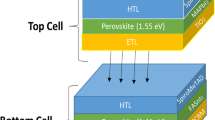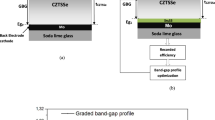Abstract
In this study, we discuss a simulation model for a tandem device with MAPbSnI3 as a bottom subcell having bandgap of 1.2 eV and MACsPb(I0.6Br0.4) as a top subcell having bandgap of 1.8 eV. These perovskite material-based top and bottom cells are first examined under standalone condition. Simulation result shows the efficiency of standalone MAPbSnI3 and MACsPb(I0.6Br0.4) devices to be 15.34% and 12.74% respectively. These results are consistent with previously reported experimental findings. We have also analyzed the effect of defect density, perovskite thickness and contact work function on overall efficiency of the solar cell. It has been found that defect density in the perovskite layer should be smaller than 1013 cm−3 and the optimal work function for the front contact of the perovskite solar cell was found to be 5.44 eV, while for the back contact it is 4.22 eV for optimal performance of the solar cell. The matching of tandem stacks is investigated in terms of the equal short-circuit currents of subcells. This condition is met at perovskite thicknesses of 400 nm and 150 nm for MAPbSnI3 and MACsPb(I0.6Br0.4), respectively. Finally, to evaluate tandem solar cell performance, the top cell was operated under the standard AM 1.5 spectrum retaining perovskite thickness at 400 nm, while the bottom cell efficiency was calculated in a filtered spectrum. Improved efficiency of 20% is obtained for the MACsPb(I0.6Br0.4)/MAPbSnI3 tandem solar cell. The analysis and findings reported in this work give a potential route for tandem solar cell design.













Similar content being viewed by others
Data Availability
Data sharing not applicable to this article as no data sets were generated or analyzed during the current study.
References
M.A. Green, E.D. Dunlop, J. Hohl-Ebinger, M. Yoshita, N. Kopidakis, and X. Hao, Solar Cell Efficiency Tables (Version 58). Prog. Photovoltaics Res. Appl. 29, 657 (2021).
W. Shockley and H.J. Queisser, Detailed Balance Limit of Efficiency of p-n Junction Solar Cells. J. Appl. Phys. 32, 510 (1961).
T. Leijtens, K.A. Bush, R. Prasanna, and M.D. McGehee, Opportunities and Challenges for Tandem Solar Cells Using Metal Halide Perovskite Semiconductors. Nat. Energy 3, 828 (2018).
T. Ameri, N. Lia, and C.J. Brabec, Highly Efficient Organic Tandem Solar Cells: a Follow up Review. Energy Environ. Sci. 6, 2390 (2013).
M. T. Islam, M. R. Jani, A. F. Islam, K. M. Shorowordi, S. Chowdhury, and S. S. Nishat, S. Ahmed, Investigation of CsSn0.5Ge0.5I3-on-Si Tandem Solar Device Utilizing SCAPS Simulation. IEEE Transactions on Electron Devices. 68, 618 (2021).
J.H. Im, C.R. Lee, J.W. Lee, S.W. Park, and N.G. Park, 6.5% Efficient Perovskite Quantum-dot-sensitized Solar Cell. Nanoscale. 3, 4088 (2011).
C.R. Kalaiselvi, N. Muthukumarasamy, D. Velauthapillai, M. Kang, and T.S. Senthil, Importance of Halide Perovskites for Next Generation Solar Cells–a Review. Mater. Lett. 219, 198 (2018).
F. Jiang, T. Liu, B. Luo, J. Tong, F. Qin, S. Xiong, and Y. Zhou, A Two-terminal Perovskite/Perovskite Tandem Solar Cell. J. Mater. Chem. A. 4, 1208 (2016).
M. Wang, J. Liu, C. Ma, Y. Wang, Li. Jianfeng, and J. Bian, Modular Perovskite Solar Cells with Cs0.05(FA0.85MA0.15)0.95Pb (I0.85Br0.15)3 Light-Harvesting Layer and Graphene Electrode. J. Elect. Mater. 51, 2381 (2022).
A. Suzuki, M. Oe, and T. Oku, Fabrication and Characterization of Ni-, Co-, and Rb-Incorporated CH3NH3PbI3 Perovskite Solar Cells. J. Electron. Mater. 50, 1980 (2021).
A. Suzuki, M. Kato, N. Ueoka, and T. Oku, Additive Effect of Formamidinium Chloride in Methylammonium Lead Halide Compound-based Perovskite Solar Cells. J. Electron. Mater. 48, 3900 (2019).
Y. Xia, C. Zhao, P. Zhao, L. Mao, Y. Ding, D. Hong, Y. Tian, W. Yan, and Z. Jin, Pseudohalide substitution and potassium doping in FA0.98K0.02Pb(SCN)2I for high-stability hole-conductor-free perovskite solar cells. J. Power Sourc. 494, 229781 (2021).
J. Liang, C. Wang, Y. Wang, Z. Xu, Z. Lu, Y. Ma, H. Zhu, Y. Hu, C. Xiao, X. Yi, and G. Zhu, All-inorganic Perovskite Solar Cells. J. Am. Chem. Soc. 138, 15829 (2016).
J. Liang, P. Zhao, C. Wang, Y. Wang, Y. Hu, G. Zhu, L. Ma, J. Liu, and Z. Jin, CsPb0.9Sn0.1IBr 2 based All-inorganic Perovskite Solar Cells with Exceptional Efficiency and Stability. J. Am. Chem. Soc. 139, 14009 (2017).
A. Rajagopal, Z. Yang, S.B. Jo, I.L. Braly, P.W. Liang, H.W. Hillhouse, and A.K.Y. Jen, Highly Efficient Perovskite-Perovskite Tandem Solar Cells Reaching 80% of the Theoretical Limit in Photovoltage. Adv. Mater. 29, 1702140 (2017).
D. Zhao, C. Chen, C. Wang, M.M. Junda, Z. Song, C.R. Grice, and Y. Yan, Efficient Two-terminal All-perovskite Tandem Solar Cells Enabled by High-quality Low-bandgap Absorber Layers. Nat. Energy 3, 1093 (2018).
T. Leijtens, R. Prasanna, K.A. Bush, G.E. Eperon, J.A. Raiford, A. Gold-Parker, and M.D. McGehee, Tin–lead Halide Perovskites with Improved Thermal and Air Stability for Efficient All-perovskite Tandem Solar Cells. Sustain. Energy Fuels. 2, 2450 (2018).
G.E. Eperon, T. Leijtens, K.A. Bush, R. Prasanna, T. Green, J.T.W. Wang, and H.J. Snaith, Perovskite-perovskite Tandem Photovoltaics with Optimized Band Gaps. Science 354, 861 (2016).
A. DeVos, Detailed Balance Limit of the Efficiency of Tandem Solar Cells. J. Phys. D: Appl. Phys. 13, 839 (1980).
N.N. Lal, T.P. White, and K.R. Catchpole, Optics and Light Trapping for Tandem Solar Cells on Silicon. IEEE Journal of Photovoltaics. 4, 1380 (2014).
M.H. Futscher and B. Ehrler, Efficiency Limit of Perovskite/Si Tandem Solar Cells. ACS Energy Lett. 1, 863 (2016).
J.P. Mailoa, C.D. Bailie, E.C. Johlin, E.T. Hoke, A.J. Akey, W.H. Nguyen, and T. Buonassisi, A 2-terminal Perovskite/Silicon Multijunction Solar Cell Enabled by a Silicon Tunnel Junction. Appl. Phys. Lett. 106, 121105 (2015).
F. Dávid, G.E. Lidón, P.D.R. Daniel, M. Cristina, W. Jérémie, and N. Bjoern, Efficient Monolithic Perovskite/Perovskite Tandem Solar Cells. Adv. Energy Mater. 7, 1602121 (2017).
J. Madan, R. Pandey. Shivani, and R. Sharma, Device simulation of 17.3% efficient lead-free all-perovskite tandem solar cell. Solar energy. 197, 212 (2020).
S.A. Moiz, A.N.M. Alahmadi, and A.J. Aljohani, Design of a Novel Lead-Free Perovskite Solar Cell for 17.83% Efficiency. IEEE Access. 9, 54254 (2021).
S. Sharma, R. Pandey, J. Madan, and R. Sharma, Optimization of Mixed Sn and Pb Perovskite Solar Cell in Terms of Transport Layers and Absorber Layer Thickness Variation. Devices for Integrated Circuit (DevIC) (2021) p. 633.
R.R. Raghvendra and S.K. Kumar, Pandey, Performance Evaluation and Material Parameter Perspective of Eco-friendly Highly Efficient CsSnGeI3 Perovskite Solar cell. Superlattices Microstruct. 135, 106273 (2019).
R. Shubham, C. Pathak, and S.K. Pandey, Design, Performance, and Defect Density Analysis of Efficient Eco-Friendly Perovskite Solar Cell. IEEE Trans Electron Dev 67, 2837 (2020).
R. Shukla, R.R. Kumar, and S.K. Pandey, Theoretical Study of Charge Carrier Lifetime and Recombination on the Performance of Eco-Friendly Perovskite Solar Cell. IEEE Trans. Electron Devices 68, 3446 (2021).
S. Bhatt, R. Shukla, C. Pathak, and S.K. Pandey, Evaluation of Performance Constraints and Structural Optimization of a Core-Shell ZnO Nanorod Based Eco-friendly Perovskite Solar Cell. Sol. Energy 215, 473 (2021).
Raghvendra, RR. Kumar, and SK. Pandey Performance Improvement and Defects Analysis in Pervoskite based Solar Cell. 2019 IEEE 46th Photovoltaic Specialists Conference (PVSC) (2019) p. 1191.
Y. Yang and J. You, Make Perovskite Solar Cells Stable. Nature 544, 155 (2017).
Y.-M. Xie, Q. Yao, Z. Zeng, Q. Xue, T. Niu, R. Xia, Y. Cheng, F. Lin, S.-W. Tsang, and Y. Cao, Homogeneous Grain Boundary Passivation in Wide-bandgap Perovskite Films Enables Fabrication of Monolithic Perovskite/Organic Tandem Solar Cells with Over 21% Efficiency. Adv. Func. Mater. 32, 2112126 (2022).
Y. Tong, A. Najar, Lu. Le Wang, M. Du Liu, J. Yang, J. Li, K. Wang, and S. Liu, Wide-Bandgap Organic-Inorganic Lead Halide Perovskite Solar Cells. Adv. Sci. 9, 2105085 (2022).
M.D. Rasidul Islam, Y. Wu, K. Liu, Z. Wang, S. Qu, and Z. Wang, Recent Progress and Future Prospects for Light Management of All-Perovskite Tandem Solar Cells. Adv. Mater. Interf. 9, 2101144 (2022).
Feng Wang, Sai Bai, Wolfgang Tress, Anders Hagfeldt, and Feng Gao, Defects engineering for high-performance perovskite solar cells. npj Flexible Electron. 2, 1 (2018).
Acknowledgments
The authors would like to thank Dr. Marc Burgelman (Department of Electronic and Information Sciences (ELIS) at the Ghent University, Belgium) for sharing the SCAPS 1D software.
Author information
Authors and Affiliations
Corresponding author
Ethics declarations
Conflict of interest
The authors declare that they have no conflict of interest.
Additional information
Publisher's Note
Springer Nature remains neutral with regard to jurisdictional claims in published maps and institutional affiliations.
Rights and permissions
About this article
Cite this article
Raghvendra, Kumar, R.R. & Pandey, S.K. Device Modeling and Optimization for an Efficient Two-Terminal Perovskite Tandem Solar Cell. J. Electron. Mater. 51, 6603–6613 (2022). https://doi.org/10.1007/s11664-022-09902-2
Received:
Accepted:
Published:
Issue Date:
DOI: https://doi.org/10.1007/s11664-022-09902-2




